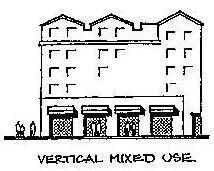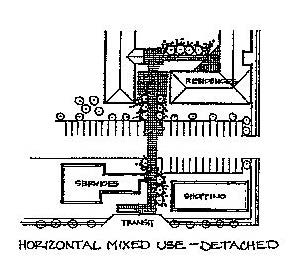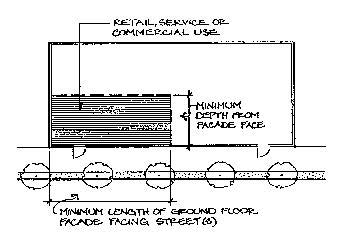Chapter 15.520
MIXED USE DEVELOPMENT DESIGN STANDARDS
Sections:
15.520.010 Authority and Application
15.520.100 Definition of Mixed Use
15.520.200 Ground Floor Uses in Mixed Use Projects
15.520.300 Mixed Use in Residential Projects
15.520.005 Purpose
The purpose of this chapter is to establish mixed use standards for required commercial and residential mixed use projects. (Ord. 15-1018 § 1)
15.520.010 Authority and Application
The provisions of this chapter shall apply to commercial and residential mixed use projects as required by the citywide use chart in SMC 15.205.040. (Ord. 15-1018 § 1)
15.520.100 Definition of Mixed Use
For the purposes of this chapter, mixed use refers to the combining of retail/commercial and/or service uses with residential or office use in the same building or on the same site in one (1) of the following ways:
A. Vertical Mixed Use. A single structure with the above floors used for residential or office use and a portion of the ground floor for retail/commercial or service uses.
B. Horizontal Mixed Use – Attached. A single structure which provides retail/commercial or service use in the portion fronting the public or private street with attached residential or office uses behind.
C. Horizontal Mixed Use – Detached. Two (2) or more structures on one (1) site which provide retail/commercial or service uses in the structure(s) fronting the public or private street, and residential or office uses in separate structure(s) behind or to the side. (Ord. 15-1018 § 1)
15.520.200 Ground Floor Uses in Mixed Use Projects
A. Ground Floor Use Requirements. A minimum of fifty percent (50%) of the length of the exterior ground floor facing the street(s), excluding vehicle entrances, exits, and alleys, shall be designed to be occupied by a retail/commercial or service use.
B. Ground Floor Depth. The leasable ground floor area shall extend in depth a minimum of thirty (30) feet from the exterior building facade; provided, that the minimum required may be averaged, with no depth less than fifteen (15) feet.
C. Types of Retail/Commercial or Service Uses Allowed.
1. Retail/Commercial. Retail/commercial uses such as retail food shops, groceries, drug stores, florists, apparel and specialty shops, hotels/motels, restaurants, and other retail/commercial uses that are not specifically auto-oriented in scale or nature.
2. Services. General offices, such as professional, financial, insurance and real estate services; or personal services, such as beauty salons, dry cleaners, shoe repair shops, banks, health and social services, libraries and health clubs.
D. Interior Ceiling Height. The minimum clear interior ceiling height standard for the retail/commercial or service use portion of mixed use buildings shall be a minimum ten (10) feet for all street level building space.
E. Design Standards.
1. Pedestrian-Level Architecture. Pedestrian-level commercial uses in vertical mixed use projects shall be distinguished architecturally from attached residential units and shall utilize separate entrances where feasible.
2. Identity Signs. Ground floor businesses shall provide business identity signs that fit with the architectural character of the site and shall conform to all other applicable sign requirements identified in the SeaTac Municipal Code. 
(Ord. 15-1018 § 1)
15.520.300 Mixed Use in Residential Projects
In order to create a street environment that facilitates pedestrian activity and convenience, ground floor space in residential mixed use projects shall be used for pedestrian-oriented retail, service, or commercial uses such as those specified below, except within the designated City Center, Angle Lake Station Area, and S. 154th St. Station Area Overlay Districts.
A. Retail. Retail uses such as retail food shops, groceries, drug stores, florists, apparel and specialty shops, and other retail uses that are not specifically auto-oriented in scale or nature.
B. Services. Personal, professional, financial, insurance and real estate services, such as beauty salons, dry cleaners, shoe repair shops, banks, health and social services, libraries, health clubs.
C. Commercial. Hotels and general offices. (Ord. 16-1009 § 20; Ord. 15-1018 § 1)


